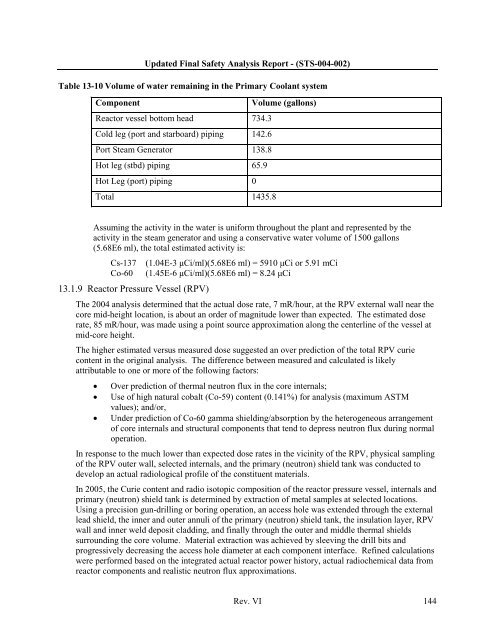10 CFR 50.71(e) - Maritime Administration - U.S. Department of ...
10 CFR 50.71(e) - Maritime Administration - U.S. Department of ...
10 CFR 50.71(e) - Maritime Administration - U.S. Department of ...
Create successful ePaper yourself
Turn your PDF publications into a flip-book with our unique Google optimized e-Paper software.
Updated Final Safety Analysis Report - (STS-004-002)Table 13-<strong>10</strong> Volume <strong>of</strong> water remaining in the Primary Coolant systemComponentVolume (gallons)Reactor vessel bottom head 734.3Cold leg (port and starboard) piping 142.6Port Steam Generator 138.8Hot leg (stbd) piping 65.9Hot Leg (port) piping 0Total 1435.8Assuming the activity in the water is uniform throughout the plant and represented by theactivity in the steam generator and using a conservative water volume <strong>of</strong> 1500 gallons(5.68E6 ml), the total estimated activity is:Cs-137Co-6013.1.9 Reactor Pressure Vessel (RPV)(1.04E-3 μCi/ml)(5.68E6 ml) = 59<strong>10</strong> μCi or 5.91 mCi(1.45E-6 μCi/ml)(5.68E6 ml) = 8.24 μCiThe 2004 analysis determined that the actual dose rate, 7 mR/hour, at the RPV external wall near thecore mid-height location, is about an order <strong>of</strong> magnitude lower than expected. The estimated doserate, 85 mR/hour, was made using a point source approximation along the centerline <strong>of</strong> the vessel atmid-core height.The higher estimated versus measured dose suggested an over prediction <strong>of</strong> the total RPV curiecontent in the original analysis. The difference between measured and calculated is likelyattributable to one or more <strong>of</strong> the following factors:Over prediction <strong>of</strong> thermal neutron flux in the core internals;Use <strong>of</strong> high natural cobalt (Co-59) content (0.141%) for analysis (maximum ASTMvalues); and/or,Under prediction <strong>of</strong> Co-60 gamma shielding/absorption by the heterogeneous arrangement<strong>of</strong> core internals and structural components that tend to depress neutron flux during normaloperation.In response to the much lower than expected dose rates in the vicinity <strong>of</strong> the RPV, physical sampling<strong>of</strong> the RPV outer wall, selected internals, and the primary (neutron) shield tank was conducted todevelop an actual radiological pr<strong>of</strong>ile <strong>of</strong> the constituent materials.In 2005, the Curie content and radio isotopic composition <strong>of</strong> the reactor pressure vessel, internals andprimary (neutron) shield tank is determined by extraction <strong>of</strong> metal samples at selected locations.Using a precision gun-drilling or boring operation, an access hole was extended through the externallead shield, the inner and outer annuli <strong>of</strong> the primary (neutron) shield tank, the insulation layer, RPVwall and inner weld deposit cladding, and finally through the outer and middle thermal shieldssurrounding the core volume. Material extraction was achieved by sleeving the drill bits andprogressively decreasing the access hole diameter at each component interface. Refined calculationswere performed based on the integrated actual reactor power history, actual radiochemical data fromreactor components and realistic neutron flux approximations.Rev. VI 144
















